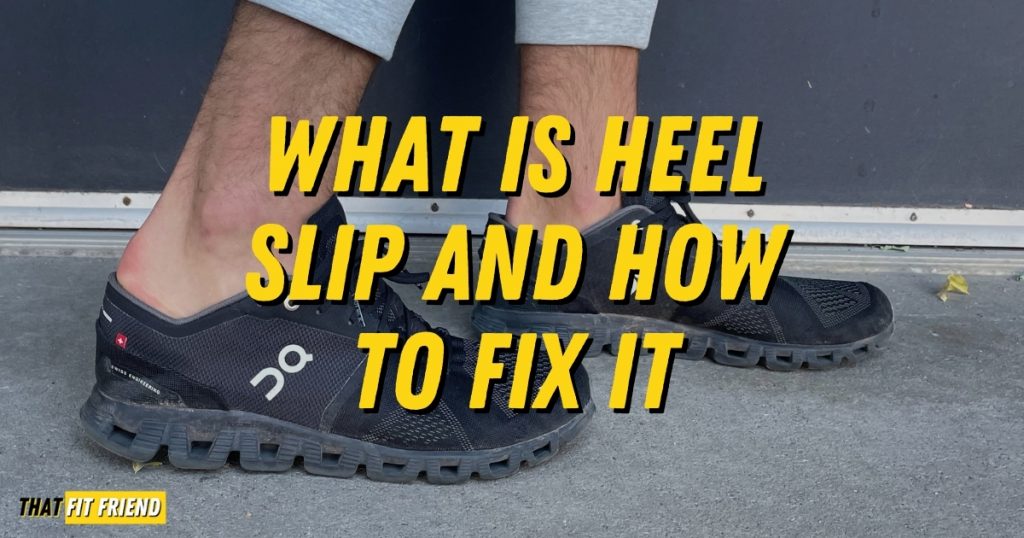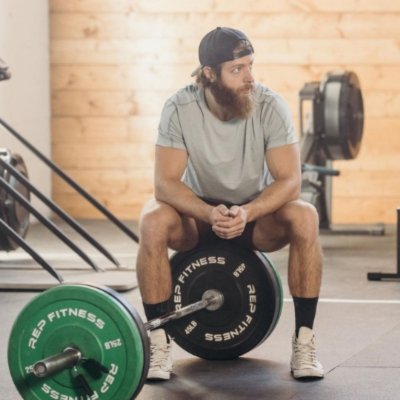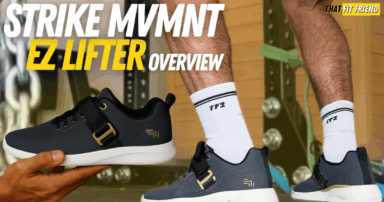Table of Contents+
If you’ve worn a really poor-fitting pair of training shoes, then you may have some experience or exposure to heel slip. Heel slip is something that can be incredibly frustrating for lifters and athletes who are trying to get the most out of their shoes.
On my YouTube channel, I’m constantly answering training shoe sizing questions and working to help others navigate issues like heel slip. Shoe sizing can be really tough to navigate at times due to how individual all of our feet are and how many different shoe lasts exist.
In this article, I’m going to discuss heel slip and how to navigate around it. If you’re noticing that your heels are popping out of your training shoes, then read on and we’ll discuss what to do about it.
Heel slip is the act of a shoe sliding up and down your heel when you’re walking, jumping, and working out. This can lead to a variety of issues like blisters and changes in movement mechanics.
How to Prevent Heel Slip
If you’re experiencing heel slip in your training shoes, then there are a couple of things to do and try in order to navigate around this issue without fully ditching hopes of wearing the model in question.
1. Try Using a Lace-Lock (Heel Lock) Technique
2. Try Sizing Down a Half Size
The first potential fix for heel slip is to try going down a half size. This is the easiest potential fix and will be best for those that are experiencing heel slip due to excessive room in the toe box.
If you find that you have about an inch of space at the end of your toe box, then you should try sizing down a half size to see if this limits the heel slip issues you’re having. Ideally, you want anywhere from .2-.3″-.6-.7″ of clearance in the toe box.
Now, let’s say you’re having heel slip issues and the shoe fits true in regard to length, should you size down? No, because the shoe already fits well in regard to length, and sizing down could make it too tight.
More than likely, for this scenario you may just need to explore other models because the shoe’s last in question is not aligning with your foot anatomy.
What Is Heel Slip?
Heel slip is the act of the heel popping out of the boot of the shoe unintentionally during various movements. Heel slip severity in your shoes can vary and the act of heel slip can present itself at different times based on the activity you’re performing, how your foot is built, and how the shoe you’re wearing is built.
For example, if your shoes fit very poorly and you’re experiencing a lot of heel slip, then you can experience heel slip when doing low-intensity exercises like walking.
Conversely, if your shoes fit okay but there are still discrepancies between your shoe’s sizing and your foot anatomy, then you may only notice heel slip when doing things like plyometrics, lifting, and other high-intensity exercises.
The latter of the two examples discussed above is the most common in which heel slip will present itself during one’s time wearing a pair of shoes.
With high-velocity and high-intensity exercise, we’ll be placing a greater demand on the ankles and their function more specifically when they’re moving through plantarflexion and dorsiflexion.
Plantarflexion is when we flex the ankle downward with the balls of the feet driving into the ground, and dorsiflexion is when we flex the ankle with the toe pointing towards the feeling.
When we move through rapid rates of plantarflexion and dorsiflexion, we can run into problems with the heel slipping out of our shoe’s boot if the shoes we’re wearing don’t fit properly.
This can be even more prevalent when we consider multi-directional activity, too, AKA moving forward, laterally, and backward with our weight as a whole shifting into these directions.
Why Is Heel Slip Bad?
There are a few reasons why heel slip with your shoes can be detrimental for both working out and daily wear. The severity of heel slip and how much it will impact you will vary based on what you’re doing.
1. It Makes Your Shoes Feel Less Secure
First, it can hinder your workout performance by making your shoes feel less secure. For example, let’s say you’re doing a box jump and you have heel slip during the take-off phase.
This can throw off your confidence with your jump and cause issues during the landing phase of your jump.
2. It Can Cause Blisters Due to Friction and Rubbing
Second, heel slip can cause blister issues on the ankle and Achilles tendon. When we have shoes that are constantly sliding up and down the Achilles and ankle, then we can run into blister issues due to the increased friction.
Blisters can not only feel uncomfortable but also ruin our socks and stain the boots of our shoes.
3. Heel Slip Can Throw Off Your Movement
Third and lastly, heel slip can change our movement mechanics. If we notice that our shoe is sliding around when training, then we’ll start to subconsciously move in a means that allows us to feel more secure in our shoes.
Small mechanical changes can add up over time and cause decreased performance, which is the last thing we want when training consistently.
When Does Heel Slip Happen?
We touched on this point briefly above, but to provide more context and to help you understand in greater depth why heel slip can happen I wanted to dive into three specific areas that can play a role in heel slip.
1. Poor Fitting Shoes (Misaligned Shoe Lasts and Foot Anatomy)
The first and most common reason heel slip can occur is that your shoes don’t fit your foot properly. This could mean that your shoes are a bit too large in regard to length so the additional toe box room causes your foot to slide forward and your heel to pop out.
In addition, this could also mean that the last (mold) of the shoe you’re using doesn’t align with your foot’s anatomy. When building shoes, companies have hundreds of shoe lasts to select from, and they try to choose a last that will capture the widest market share. A shoe last is essentially the foot mold in which the shoe is based and sized around.
This is why some shoes, no matter how you size up, won’t align with your feet. A good example here would be an athlete or lifter with a very narrow foot trying to fit into a Reebok Nano X3 which has a slightly wider last and construction.
No matter how this athlete sizes their Nano X, they may never fit this shoe completely and that’s because the last of the shoe doesn’t align with their foot anatomy. This is normal and adds to the importance of exploring different models to find shoes that actually fit your foot’s anatomy well.
If you’re someone with a wider or more narrow foot, then you can be a bit more prone to experiencing heel slip in certain shoes. Generally, athletes and lifters with more neutral feet can get away with wearing a wider range of models without issues.
2. Low-Profile Boots
Another reason you may run into heel slip with your training shoe is their profile and boot construction. At times, a shoe’s boot construction can be the sole reason for heel slip with some lifters and athletes despite the shoe seemingly fitting well.
Some good cross-training shoe examples here are the Nike Metcon 6 and Nike Metcon 7, which have low-profile constructions.
Let’s say you’re someone that has a thicker heel bone and there’s less physical boot construction making contact with your heel in something like a Nike Metcon 8 and Metcon 7.
In this case, you may experience heel slip despite technically having your sizing right because there’s less material to help keep the boot secure on the heel.
The big takeaway here is that sometimes heel slip is inevitable in shoes you’re wearing and that can be due to how a shoe is built and how it interacts with your individual foot and ankle anatomy.
Not every shoe is going to work with our feet and that’s normal, and we’re not weird for having some issues that just don’t agree with us.
Wrapping Up
Heel slip can be incredibly frustrating, especially in the context of training shoes. Heel slip can not only hinder performance in the gym but can also cause blisters which is less than ideal for long-term performance and comfort.
If you have any questions about heel slip and what to do to navigate around it, feel free to drop comments below or reach out to me personally via Instagram (@jake_boly).

















Calvin
Your lace lock steps workef me. I wore a pair of On Running runners that slipped at the heel on some movements in high entense exercise. I even had my heel completely lift out of the shoe once which I almost twisted my ankle. I blame a sweaty workout without socks for that one.
Stoked this article helped!
Andrea
Thank you super useful way of lacing up the shoes!
So glad this article helped!
Niki
Thanks for the info/demo on lace locking!
I just bought a pair of Hoka Challenger ATR 6s in a D fitting.I already had them in a B width size 8.5 but have wide feet (wear NB 860 size 8 but 2E) so when I saw these on special I nabbed them, since the B width is quite snug across the toes, though fine in the heel. The only issue with the new wider ones is that now the heel feels less secure, so I’m going to try lace locking.
I’m a walker not a runner, but the trails around home are very uneven and pebbly, hence going for an all-terrain shoe but with versatility and plenty of cushioning!
Awesome! Glad the article and helped and I hope the tips helped. Thank you for sharing your experiences!
Shanna
OMG I have the hardest time with this! I’m a female with Cavus arch, wide foot, and thick heel. Once I get the arch support I must have, the heels are so shallow! Any suggestions on wide shoes with a deep fit? Bonus if they don’t break the bank. Thanks!
Hey! I have a few that come to mind, what’s the primary use for the shoes? General workouts, HIIT, lifting, etc.? Can make better recs based on your needs!
Joedawg
I’ve had some good success with thicker-padded socks (I think my foot is a little narrow and my heel pops up and out causing blisters).
For the gym, I get the thickest ankle or calf socks I can find (some good options at Target, FITS is also good).
For no-show socks for when I’m out and about, I’ve had good luck with Skinnys (they’re pricy, but they’re the only no-shows I’ve had that prevent my heel from slipping). Can buy them online.
Love it! Thank you for sharing additional tips.
Vanshaj
Hey mate,i have been trying to fix heel slip. In my case,i m a fast bowler in cricket. We wear spikes shoes. My problem is that my heel slip rightwards during bowling and this cause discomfort as well as half the life of my shoe. My shoe often get torn very soon and everytime from the heel’s right side. I have recently purchased a new Asics shoe(one of the best fast bowling shoe). And now it have just started to get torn from side.My this shoe is very well fit from ball of foot but a bit loose from heel which cause my heel slip rightwards.So,now I can’t buy a new one of smaller size.So,can you please give any idea to fix it. Will be really grateful to you.
You could always try thicker socks when you’re playing. That may help with slip and prevent some of that friction. My main fix would be to go down a little bit in size though so you don’t have that space causing friction, but for the time being, thicker socks and/or lace-locking to get the shoe tighter could be a decent interim fix!
Tammy
Hi Jake! I’m a group fitness instructor and I just ordered some slip on shoes online. I get heel slip when I wear them, but I think my toe is in the right place. Is this how a slip on shoe is supposed to fit before being broken in or are they too big? According to the website, I can’t exchange them for a different size. Is there a way to make them feel tighter in the heel?
Hey Tammy! Which model did you order if you don’t mind me asking? It’s interesting because some models you may experience slip with despite having the toes and size right. For example, some athletes have heel slip when in Metcons despite their fit being correct — this is typically due to foot anatomies not aligning with a shoe’s last.
You could try rocking thicker socks to see if that helps a bit!
Tammy
Hi again! The model number is Z1F000013. Thank you for the sock advice! It is hard to tell with these shoes if they are too big or if my foot anatomy doesn’t align in the heel. Do you still think it would be okay to teach a class with shoes that cause heel slip? They don’t come off when I shake my foot, but they just feel loose in the back when I move around. What do you think?
Gotcha! In that case, they’re probably fine then, especially if you’re just doing casual stuff in them and they’re not impacting your movement or performance in any way. I would just be conscious of demo-ing movements where heel slip could cause an issue with movement mechanics!
Jose
Hi Jake!
I’m wondering how much is too much heel slip! Just got some Nano X2 and I’ve got some heel slip on them, although not massive. The runner’s knot is not possible as you outlined yourself in your review (short laces), although lacing them very tight using the last eyelet seems to take it away (at the cost of tightness right on the knot). Otherwise, I can kinda squeeze a finger in between my foot and the end of the shoe if I force it all the way down.
Do you think I should return em and just get any others? They’ve run out of smaller sizes and I got em at 60% price, so I’m hesitating quite a bit due to both these facts.
Thanks in advance! Loved your channel and articles, they’ve been quite revealing to me 🙂
Hey, Jose! As much as I hate to say it because you got a good deal on them — I’d suggest returning them and going for a .5 size smaller just to be safe. That sounds like a littttttle too much room and they’ll only stretch out more as you wear them which could make the slip worse.
May be worth waiting for a Nano X2 restock/Nano 6000 or looking into something like the Nano X1 Adventure in the same size that would be .5 size smaller (since they size similarly as the Nano X2).
And thank you so much!
Jose
Thanks for your reply, Jake! I feared as much but was hopeful there was still hope!
I think I’ve got played by the sizing as I’m from Europe – Nike and Adidas EU46 fit me good, but I went with 45.5 for the Reebok right away as over 10 years ago I remember they were larger than Nike… Still was not enough. Comparing the size with Adidas, Nike and Reebok, EU and US sizes differed across all models, while the only consistent size was UK11. Absolute pity, I will look into a half size less, but also on other models like the ones you’ve mentioned.
Thanks once more!
I really wish companies would all have consistent sizing in regard to length, because to your point, there’s always so much variance. Widths/volumes can vary, but at least make lengths consistent. For example, I just received “The Total” from Adidas and I ordered a 9.5 (normally a 10) and I’m swimming in them which is odd because in pretty much all Adidas shoes I’m a 10, lol.
Sorry for the frustrating sizing fiasco — I feel your pain and you’re welcome! Shout if I can do anything else for you.